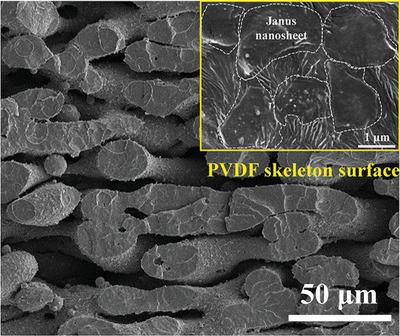当前位置:
X-MOL 学术
›
Macromol. Rapid Commun.
›
论文详情
Our official English website, www.x-mol.net, welcomes your
feedback! (Note: you will need to create a separate account there.)
Stabilizing Polymeric Interface by Janus Nanosheet.
Macromolecular Rapid Communications ( IF 4.2 ) Pub Date : 2020-08-24 , DOI: 10.1002/marc.202000392 Jipeng Guan 1 , Haoguan Gui 1 , Yanyan Zheng 1 , Jichun You 2 , Yongjin Li 2 , Fuxin Liang 1 , Zhenzhong Yang 1
Macromolecular Rapid Communications ( IF 4.2 ) Pub Date : 2020-08-24 , DOI: 10.1002/marc.202000392 Jipeng Guan 1 , Haoguan Gui 1 , Yanyan Zheng 1 , Jichun You 2 , Yongjin Li 2 , Fuxin Liang 1 , Zhenzhong Yang 1
Affiliation

|
A strategy is proposed to stabilize the polymeric interface by using the irregular Janus nanosheet (JNS). The poly(vinylidene fluoride) (PVDF)/poly(l‐lactic acid) (PLLA) at 60/40 (wt/wt) with a bi‐continuous structure is selected as the model melt blend, and the PMMA/epoxy JNS is synthesized and used as the compatibilizer. The JNS is preferentially located at the interface. The interfacial coverage by the JNS reaches a saturated state forming the interconnected jamming structure at 0.5 wt% of the JNS. The interface is thus stabilized which is well preserved after annealing at high temperature. After selectively etching PLLA, the robust PVDF porous material is derived with the JNS armored at the pore skeleton surface. The porous material provides a universal scaffold to achieve stable functional materials after filling the pores.
中文翻译:

通过Janus Nanosheet稳定聚合物界面。
提出了一种通过使用不规则的Janus纳米片(JNS)稳定聚合物界面的策略。聚偏二氟乙烯(PVDF)/聚(l选择具有双连续结构的60/40(wt / wt)的乳酸(PLLA)作为模型熔体共混物,然后合成PMMA /环氧JNS并将其用作增容剂。JNS优先位于接口处。JNS的界面覆盖率达到饱和状态,形成互连干扰结构,占JNS的0.5 wt%。界面因此被稳定,在高温下退火之后可以很好地保留该界面。在选择性蚀刻PLLA之后,使用在孔骨架表面铠装的JNS衍生出坚固的PVDF多孔材料。多孔材料提供了通用的支架,以在填充孔后获得稳定的功能材料。
更新日期:2020-10-05
中文翻译:

通过Janus Nanosheet稳定聚合物界面。
提出了一种通过使用不规则的Janus纳米片(JNS)稳定聚合物界面的策略。聚偏二氟乙烯(PVDF)/聚(l选择具有双连续结构的60/40(wt / wt)的乳酸(PLLA)作为模型熔体共混物,然后合成PMMA /环氧JNS并将其用作增容剂。JNS优先位于接口处。JNS的界面覆盖率达到饱和状态,形成互连干扰结构,占JNS的0.5 wt%。界面因此被稳定,在高温下退火之后可以很好地保留该界面。在选择性蚀刻PLLA之后,使用在孔骨架表面铠装的JNS衍生出坚固的PVDF多孔材料。多孔材料提供了通用的支架,以在填充孔后获得稳定的功能材料。











































 京公网安备 11010802027423号
京公网安备 11010802027423号